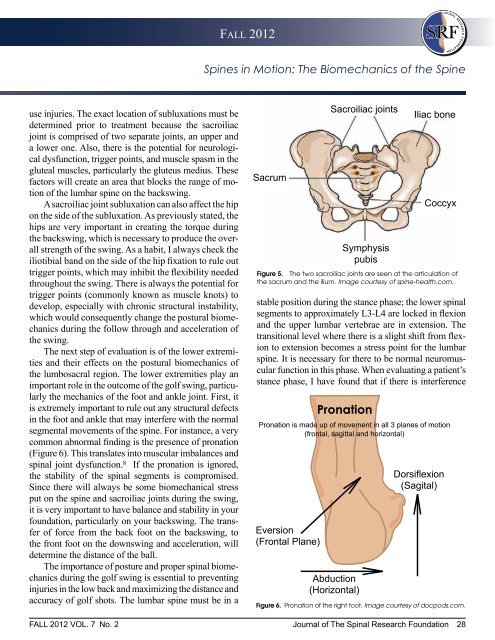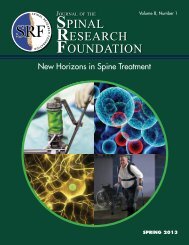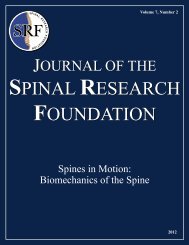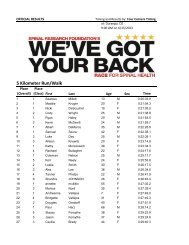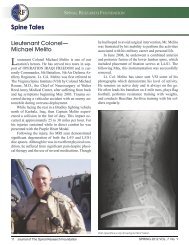Journal of - Spinal Research Foundation
Journal of - Spinal Research Foundation
Journal of - Spinal Research Foundation
Create successful ePaper yourself
Turn your PDF publications into a flip-book with our unique Google optimized e-Paper software.
FALL 2012Spines in Motion: The Biomechanics <strong>of</strong> the Spineuse injuries. The exact location <strong>of</strong> subluxations must bedetermined prior to treatment because the sacroiliacjoint is comprised <strong>of</strong> two separate joints, an upper anda lower one. Also, there is the potential for neurologicaldysfunction, trigger points, and muscle spasm in thegluteal muscles, particularly the gluteus medius. Thesefactors will create an area that blocks the range <strong>of</strong> motion<strong>of</strong> the lumbar spine on the backswing.A sacroiliac joint subluxation can also affect the hipon the side <strong>of</strong> the subluxation. As previously stated, thehips are very important in creating the torque duringthe backswing, which is necessary to produce the overallstrength <strong>of</strong> the swing. As a habit, I always check theiliotibial band on the side <strong>of</strong> the hip fixation to rule outtrigger points, which may inhibit the flexibility neededthroughout the swing. There is always the potential fortrigger points (commonly known as muscle knots) todevelop, especially with chronic structural instability,which would consequently change the postural biomechanicsduring the follow through and acceleration <strong>of</strong>the swing.The next step <strong>of</strong> evaluation is <strong>of</strong> the lower extremitiesand their effects on the postural biomechanics <strong>of</strong>the lumbosacral region. The lower extremities play animportant role in the outcome <strong>of</strong> the golf swing, particularlythe mechanics <strong>of</strong> the foot and ankle joint. First, itis extremely important to rule out any structural defectsin the foot and ankle that may interfere with the normalsegmental movements <strong>of</strong> the spine. For instance, a verycommon abnormal finding is the presence <strong>of</strong> pronation(Figure 6). This translates into muscular imbalances andspinal joint dysfunction. 8 If the pronation is ignored,the stability <strong>of</strong> the spinal segments is compromised.Since there will always be some biomechanical stressput on the spine and sacroiliac joints during the swing,it is very important to have balance and stability in yourfoundation, particularly on your backswing. The transfer<strong>of</strong> force from the back foot on the backswing, tothe front foot on the downswing and acceleration, willdetermine the distance <strong>of</strong> the ball.The importance <strong>of</strong> posture and proper spinal biomechanicsduring the golf swing is essential to preventinginjuries in the low back and maximizing the distance andaccuracy <strong>of</strong> golf shots. The lumbar spine must be in aFALL 2012 VOL. 7 No. 2SacrumFigure 5. The two sacroiliac joints are seen at the articulation <strong>of</strong>the sacrum and the ilium. Image courtesy <strong>of</strong> spine-health.com.stable position during the stance phase; the lower spinalsegments to approximately L3-L4 are locked in flexionand the upper lumbar vertebrae are in extension. Thetransitional level where there is a slight shift from flexionto extension becomes a stress point for the lumbarspine. It is necessary for there to be normal neuromuscularfunction in this phase. When evaluating a patient’sstance phase, I have found that if there is interferenceEversion(Frontal Plane)Sacroiliac jointsSymphysispubisPronationAbduction(Horizontal)Iliac boneCoccyxPronation is made up <strong>of</strong> movement in all 3 planes <strong>of</strong> motion(frontal, sagittal and horizontal)Dorsiflexion(Sagital)Figure 6. Pronation <strong>of</strong> the right foot. Image courtesy <strong>of</strong> docpods.com.<strong>Journal</strong> <strong>of</strong> The <strong>Spinal</strong> <strong>Research</strong> <strong>Foundation</strong> 28


